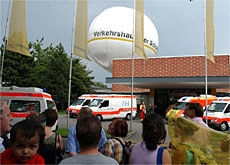Balloon accident blamed on human error

Investigators have blamed human error for a hot-air balloon accident at the Swiss Transport Museum last July that left an Indian tourist dead.
Ten other passengers were seriously injured when strong winds slammed the balloon against the museum in the central Swiss city of Lucerne.
A report by the Aircraft Accident Investigation Bureau (AAIB), published on Thursday, found that the tethered balloon, known as the “Hiflyer”, was carrying too many passengers when it made an ascent in dangerous weather conditions.
In high winds, the balloon went out of control 40 metres above the ground, crashing several times against the museum building and a tree.
During an attempt to bring the balloon back down to the ground, the winch cable sliced through a floor panel in the gondola and one of the passengers, a woman, fell through the opening.
“The accident is attributable to the fact that on the occasion of an ascent in conditions with excessively high wind speeds and in an overloaded condition, the gondola… was damaged by a winch cable in such a way that a passenger fell to earth, suffering fatal injuries,” stated the AAIB report.
In its findings, the agency criticised the balloon crew for carrying out two extra trips – including the fatal one – in “critical weather conditions”.
It noted that a wind warning from Meteoswiss, a national weather service, had arrived by fax at the Hiflyer’s operations centre, but had not been brought to the attention of the balloon pilots.
Storm warning
Accident investigators also highlighted the fact that there were no storm warning lights in the vicinity of the Hiflyer site.
They also said the location of the balloon close to buildings was “sub-optimal”.
“There were indications that even before the accident, ascents had been carried out outside permissible wind speeds,” added the report.
“Between April 1 and July 23 2004, some 24 per cent of all ascents were made in overloaded conditions.”
The AAIB issued 15 safety recommendations, including the installation of a storm warning light near the balloon platform.
The agency also advised the manufacturer of the Hiflyer to consider the development of an electronic overload warning system.
New regulations
Reacting to the report’s findings, the Federal Civil Aviation Office said it planned to tighten regulations and training for tethered balloon operators and pilots.
It added that the Hiflyer would remain grounded until the new measures were in place.
The Swiss Transport Museum said it was ready to comply with any new safety directives on tethered balloons and hoped to relaunch a new Hiflyer next year.
But Daniel Suter, director of the museum, said he did not believe highly trained pilots were needed to fly tethered balloons.
He said the cost of a new balloon would run to SFr700,000 ($606,000), not including any new safety measures.
The Federal Prosecutor’s Office is examining whether there is a case to answer for negligent homicide and negligent bodily harm.
swissinfo
The accident took place on July 23, 2004.
One person died and ten were seriously injured.
The balloon pilot and 14 passengers escaped unhurt.
It was the first accident since the Hiflyer opened in 2000.

In compliance with the JTI standards
More: SWI swissinfo.ch certified by the Journalism Trust Initiative

You can find an overview of ongoing debates with our journalists here. Please join us!
If you want to start a conversation about a topic raised in this article or want to report factual errors, email us at english@swissinfo.ch.